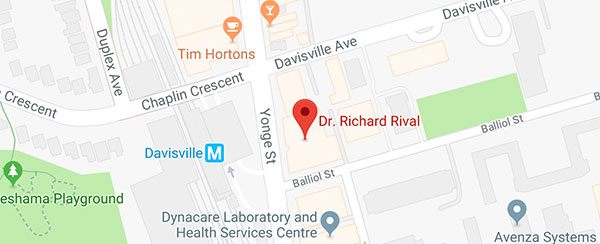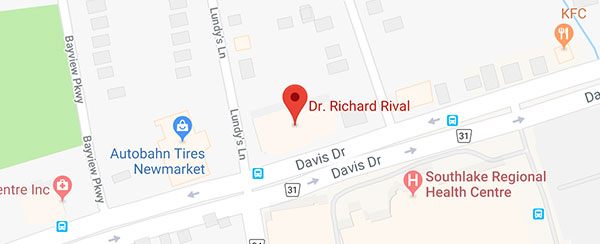Toronto Office
Dr. Richard Rival
501-1881 Yonge Street
Toronto, ON M4S 3C4
Phone: (866) 229-3223
Outside Ontario: (905) 830-6711
Monday–Friday: 9 a.m.–5 p.m.
Newmarket Office
Dr. Richard Rival
712 Davis Drive, Suite 101A
Newmarket, ON L3Y 8C3
Phone: (905) 830-6711
Outside Ontario: (905) 830-6711
Monday–Friday: 9 a.m.–5 p.m.
Beauty at Every Age
by Alison Wood for Elevate Magazine March/April 2009, www.elevatemagazine.com
A decade-by-decade guide to putting your best face forward.
Wondering what your skin will look like down the road? Take a peek at your parents. Genetics play a key role in how skin ages. But professionals say how you live those years is equally important.
“They say at 21 you get the face you were born to have and at 60 you get the face you deserve,” explains Dr. Richard Rival, MD, FRCSC, a facial plastic surgeon with offices in Toronto and Newmarket, Ont. “In other words, how you live your life affects the way you age.” Experts agree it comes down to the three S’s: smoking, stress and sun exposure, plus diet and exercise habits. Here’s what happens to your skin as you get older and how you can keep your glow:
TWENTIES
Your skin normally shows very little signs of aging in this decade. “Assuming there are no hereditary issues, it’s all about prevention,” says Dr. Stephen Mulholland, MD, FRCSC, a plastic and reconstructive surgeon from SpaMedica in Toronto. Low-commitment and non-invasive procedures such as microdermabrasion and light chemical peels like glycolic acid can help improve your skin’s tone and texture.
If you suffer from acne it should be treated now to prevent scarring down the road. In addition to remedies such as benzyl peroxide, salicylic acid and oral or topical antibiotics and retinoids, skin experts are using Intense Pulsed Light (IPL) to kill the bacteria that cause the infection leading to spots. Laser treatments can reduce acne scarring.
Some women have congenital bags under the eyes which can be treated with conservative lower eyelid surgery (blepharoplasty), explains Dr. Rival, adding that rhinoplasty is the most common facial surgery done in this age group. Although more popular in later decades, Botox is also being started in this decade to prevent expression lines from forming.
Your 20s is also the time to adopt a good skin health program. Minimizing sun exposure and regularly using a full spectrum sun block is your No. 1 defense. Look for one that protects against UVA, UVB and UVC rays. Antioxidants making news are coffeeberry and vitamins C and E, notes Dr. Nathan Rosen, MD, FRCPC, a dermatologist at Dermetics in Burlington, Ont.
THIRTIES
This is the time when the first signs of aging start to appear. Skin begins to thin, sun damage (brown/yellow spots, freckles, broken blood vessels) starts to show and there may be signs of early laxity— drooping of the outside eyebrow. Expression lines between the eyes, on the forehead and around the eyes become evident, in addition to folds around the mouth and lines around the lips. There may even be some extra tissue beneath the neck.
“Women in this decade will benefit from a preventative skin care routine,” explains Dr. Rival. “Light peels and microdermabrasion are still useful treatments for maintaining skin tone and texture. IPL is used to treat skin discolouration (including rosacea).”
In addition, doctors are utilizing Thermage, a treatment that uses radio frequency to tighten collagen, and other minimally invasive laser treatments to address skin texture. This is also the time for Botox (if not started earlier) to treat the lines of facial expression and prevent them from becoming ingrained.
As the skin deteriorates it begins to lose volume, particularly beneath the eyes, in the cheeks and around the mouth. But injectable fillers help plump it up, says Dr. Mulholland, naming hyaluronic acid— a natural substance found in the body— as one of the most popular ingredients. Injected deep beneath the surface, it fills deflated areas for anywhere from four months to more than a year in some cases. Sculptra— a synthetic but biocompatible material called poly-L-lactic acid— stimulates collagen production to thicken and smooth skin. Taking up to six treatments, results can last as long as two years.
FORTIES
Gravity is having its way this decade. Expect to see more jowl, hollowing beneath the eyes, fat loss in the cheeks and loosening of skin— making grooves around the mouth more prominent, describes Rosen. The browline is also descending, causing some eyelid hooding, and expression lines are becoming more deeply ingrained.
The good news is your skin usually still has good elasticity, making facial fillers advantageous. Botox targets facial expression lines, while IPL, thermage and laser procedures address skin tone, tightening and texture. “Look at it as a ladder: you may need everything from your 20s on,” explains Rosen.
Because lasers and fillers are often part of a complete treatment plan, Rosen is studying, in his clinic, whether doing both at one time may affect the outcome. In the meantime, he suggests: “If you are having both, it may be wise to wait six weeks between the laser and filler to prevent any chance of the filler being moved.”
Although these technological advances go a long way to put off or even eliminate surgery, a browlift along with lower or upper eyelid surgery is commonly done at this time to address the aging that occurs around the eyes, says Rival. Some women in their late 40s may even consider a limited facelift to address the jowls and neck area.
FIFTIES + BEYOND
Years of sun exposure add up to noticeable deflation, descent and deterioration in this decade, says Dr. Mulholland.
“This may be the time where more invasive treatments may be considered to treat the effects of facial aging,” explains Dr. Rival. “Botox and fillers are still helpful, but may not have the same effect if there is significant lax tissue to deal with.” More invasive laser treatments may be considered to treat the fine lines, wrinkles and age/sun spots. For good results with little downtime, doctors are touting fractional laser surfacing, where tiny pinpoints of laser light hit the surface of the skin in only a fraction of the area, leaving healthy skin in between the ablated areas. For volume, fat transfer— safe and oftentimes longer lasting than other fillers— may be considered to plump up the cheeks, hollows beneath eyes, the jawline and lips.
Facial surgery is most commonly considered in this decade, either a full facelift or mini-lifts in the brow, eyes and jaw, neck and jowl areas.


